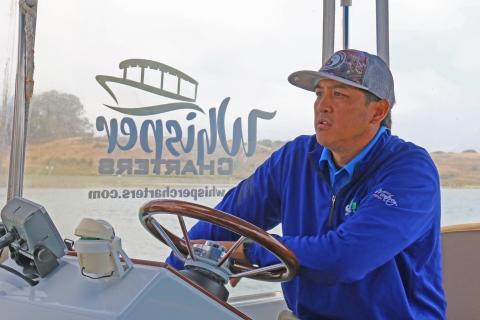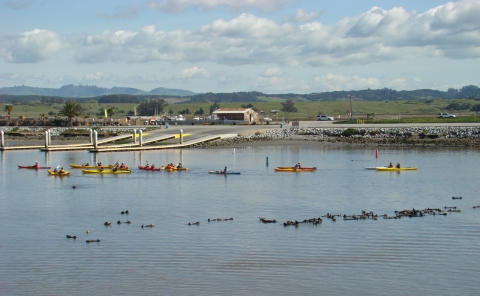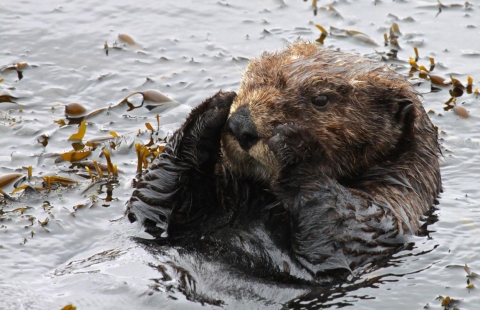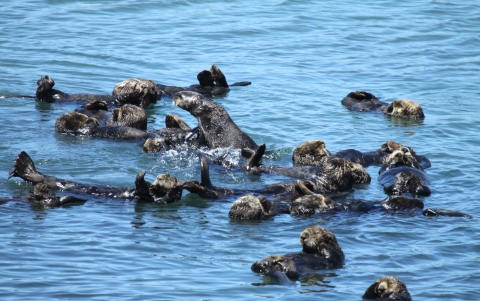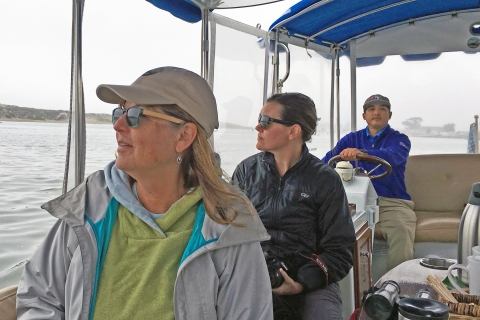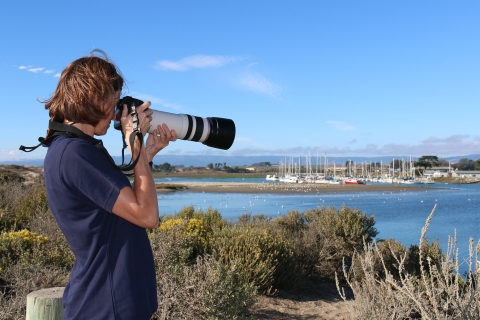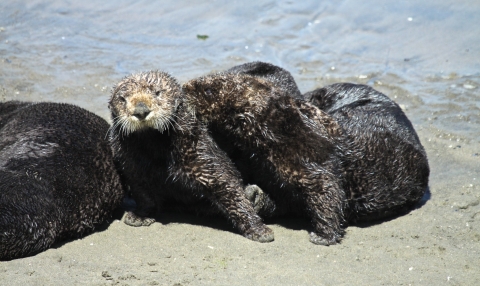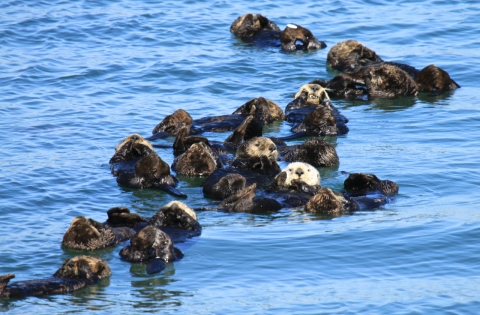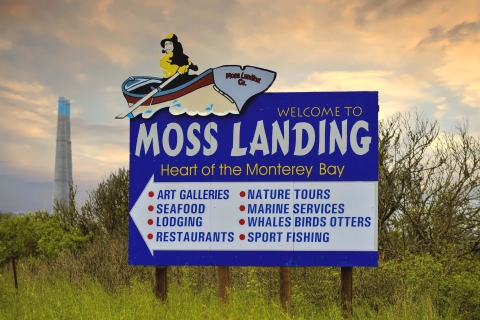Joonya Lopez steers his quiet, 22-foot electric boat carefully around the boat docks, coming up parallel to a group of a hundred or so harbor seals basking in rays of sunlight peeking through an overcast sky.
The bank is teeming with wildlife, from pelicans and cormorants to gulls and other seabirds. It’s a serene morning at Elkhorn Slough, one of the largest wetlands in the state of California. It’s 20 miles north of Monterey in the town of Moss Landing, population 204.
Gena Bentall raises her binoculars to get a closer look at kayakers near a group of sea otters resting in the water. She likes what she sees.
“They’re doing exactly what they’re supposed to be doing: staying parallel, about 20 meters away from the otters so as not to disturb them,” she says.
Southern sea otters are a protected species under the Endangered Species Act and Marine Mammal Protection Act, instrumental laws that protect imperiled species from disturbance and harm. The U.S. Fish and Wildlife Service (Service) works with partners to recover the southern sea otter and educate the public about their important role in our coastal ecosystems.
The return of southern sea otters to parts of the central California coast like Elkhorn Slough has meant a boost in visitors — a boost to the tiny town’s local economy, too.
“Moss Landing is the best-kept secret in Monterey County,” says Michele Alcantara, president of the Moss Landing Chamber of Commerce. “The southern sea otter thrives here, and Elkhorn Slough is one of the best places to witness them.”
Bentall, a resident of the Monterey Bay area for 15 years, attests that the ecotourism industry in this small town is growing. “People really want to get out on the water and experience these wild places,” she says.
But this increase in visitation concerns Bentall and other researchers who study sea otters and other wildlife in the slough. Too many visitors can have unintended consequences.
‘Make things better’
Sea otters are undeniably charismatic. They have unique behaviors while feeding and grooming, and can be seen from shore or by boat. “They’re an important draw for people to come and see these places and bring vitality into these communities,” Bentall says. But sometimes, Bentall says, people just get too close.
In 2015, Bentall, with financial support from the Service, founded an educational initiative called Sea Otter Savvy. A nonprofit, it offers an organized and long-term approach to address human-caused disturbance to sea otters.
She did it, Bentall says, “to make things better.”
“What I’ve come to realize is that most people that are out on the water who are causing a disturbance to sea otters and other wildlife really aren’t doing it intentionally,” she says. “People might want to take a picture or a selfie, and they don’t know their approach is actually causing that animal to change its behavior.”
Bentall wanted to give helpful tips to boaters, kayakers, and other water-lovers about the best ways to observe sea otters and other wildlife without unknowingly causing serious harm to the animals.
She’s not going it alone. The success of Sea Otter Savvy is built on communication and collaboration — not just with businesses, but with other sea otter experts, agencies, organizations, and private citizens.
Sea Otter Savvy’s advisory panel includes staff from the Service, California Department of Fish and Wildlife, and Monterey Bay Aquarium. Much of the organization’s daily work is accomplished by volunteers. Bentall has trained some to collect data on sea otter behavior and disturbance; others she’s recruited to lead classroom programs.
Just like people, sea otters need copious amounts of rest to build energy to find food and raise their young. Unlike other marine mammals, they do not have a blubber layer as insulation against the cold. Instead, sea otters rely on their fur and burning calories to keep warm. They must eat large amounts of food to keep up their calorie count.
If people get too close while a sea otter is catching a much-needed nap, the otter will dive or swim away, burning up those much-needed calories to stay warm, forage — or, if it’s a mother, look after her pup. If that happens repeatedly, the otter will have a very tough time surviving.
“It may not seem like a big deal… one time, one picture, right?” Bentall says. “But if it’s happening throughout the day, five, 10, 20 times day, it can really add up to an impact for those animals.”
Global visitors
Sea otters are also formidable predators. They’re related to the wolverine, so it’s no surprise that they have a very powerful bite that helps them crack open crabs and other invertebrates that they collect from the slough bottoms. Like any wild animal, they can be dangerous if people get too close.
Boat operators like Whisper Charters, owned and operated by Lopez, are paving the way for eco-friendly tourism. His customers can enjoy the animals and scenery in a safe, natural and minimally invasive way.
“People are out here to enjoy and experience nature in its natural state, and watch sea otter behavior uninterrupted by our presence,” Bentall says. “By staying back, staying quiet, being observant and alert to what‘s going on around you, you’ll have the most natural experience and will also avoid doing any harm.”
People from across the globe make the trek to the central California coast to explore the slough and see the sea otters, sometimes as a stopover point en route between Los Angeles and San Francisco.
“They come all year-round,” Lopez says as he admires a cormorant feed its chick atop one of the docks. Whisper Charters has taken visitors on more than 200 trips since last winter.
“It’s not just good for business, it’s good for the community,” Lopez says. “People not only enjoy coming on the boat, but they also learn to respect the slough. We need the animals, we need the trees.
“Without the animals, we probably wouldn’t be here.”
Recovering slowly
It wasn’t all that long ago that sea otters weren’t there. They were teetering on the edge of extinction after being nearly wiped out by the maritime fur trade that began in the 1700s and lasted nearly two centuries. In the early 1800s, up to 2,000 sea otters from San Francisco Bay and nearby waters were killed per year for their fur; many thousands more were taken from other areas of California.
One remnant population numbering just a few dozen animals managed to survive off the rocky coast of Big Sur. These animals were likely saved by an accident of geography: the rugged coastline simply offered no safe anchorage for the fur hunters.
The creature once was a common sight as far north as Washington, says Lilian Carswell, the Service’s southern sea otter recovery and marine conservation coordinator. She’s studied southern sea otters since 2002.
“Today, they occupy only about 13 percent of their historic habitat,” she says. “There are miles and miles of coastline habitat that are missing a really important keystone predator.”
From a few dozen sea otters 100 years ago to today’s population estimate of around 3,000 sea otters are slowly swimming toward recovery, but they still have a long way to go.
Their population is just about at peak capacity in the central part of the range. And, at the northern and southern ends of that range, they are being picked off by hungry or curious great white sharks. These areas of high shark-caused mortality present a barrier that sea otters have a hard time getting past.
“Range expansion is essential for the recovery of southern sea otters,” Carswell says, “and expansion into historical parts of their range is critical to the health of our coastal ecosystems.”
‘Long way to go’
Sea otters are crucial in the natural food web, too. For example, their diet of sea urchins reduces the number of spiny creatures eating environmentally important kelp forests. In the slough, otters perform much the same function for seagrass beds. They eat crabs, which lessens the pressure on sea slugs — a crab delicacy — freeing the slugs to eat algae from sea grasses. That, in turn, allows sunlight to reach the grass blades.
Because sea otters live and feed along the coastline, their health can help scientists detect the presence of pollutants and potential disease-causing pathogens washing down the coastline, Carswell notes.
Programs like Sea Otter Savvy and eco-friendly operators like Whisper Charters help ensure that sea otters can thrive, even in the presence of large numbers of visitors who come to enjoy the otters and the coastal waters that are their home.
“Through our connection to Sea Otter Savvy, we are enabling businesses to prosper while ensuring that sea otters stay safe and enhancing opportunities for wildlife watchers, photographers, and marine recreationists to observe wildlife behaving naturally,” Carswell says.
Bentall agrees. “Folks like Joonya really embrace the wildlife in their community; they are ambassadors for the area,” she says. “They know the importance of the health of the ecosystem and the health of the species, because it’s a big part of their industry to have people come out to see places like Elkhorn Slough in a natural state.”
Sea otter conservation starts with its nearest neighbors, Carswell says.
“Sea otters have come a long way back from the brink of extinction in the 20th century, but they still have a long way to go.” she says. “By understanding their needs and behaviors as wild animals and respecting their space, the community of Moss Landing and the visitors who come here are contributing to their long-term recovery.”
Lopez agrees. “This is their home, we’re visiting their home as guests. We have to remember that.”

